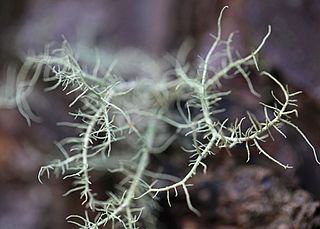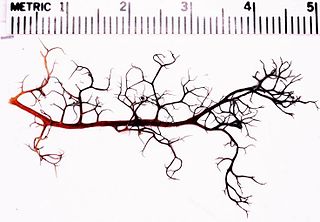
Taiga, generally referred to in North America as a boreal forest or snow forest, is a biome characterized by coniferous forests consisting mostly of pines, spruces, and larches.

Lichenology is the branch of mycology that studies the lichens, symbiotic organisms made up of an intimate symbiotic association of a microscopic alga with a filamentous fungus.

A lichen is a composite organism that arises from algae or cyanobacteria living among filaments of multiple fungi species in a mutualistic relationship. Lichens have properties different from those of their component organisms. They come in many colors, sizes, and forms and are sometimes plant-like, but are not plants. They may have tiny, leafless branches (fruticose); flat leaf-like structures (foliose); grow crust-like, adhering tightly to a surface (substrate) like a thick coat of paint (crustose); have a powder-like appearance (leprose); or other growth forms.

The northern flying squirrel is one of three species of the genus Glaucomys, the only flying squirrels found in North America. They are found in coniferous and mixed coniferous forests across much of Canada, from Alaska to Nova Scotia, and south to the mountains of North Carolina and west to Utah in the United States. They are light brown with pale underparts and grow to a length of 25 to 37 cm. They are proficient gliders but uncoordinated walkers on the ground. They feed on a variety of plant material as well as tree sap, fungi, insects, carrion, bird eggs and nestlings. They mostly breed once a year in a cavity lined with lichen or other soft material. Except when they have young, they change nests frequently, and in winter a number of individuals may huddle together in a shared nest. Unlike most members of their family, flying squirrels are strictly nocturnal.

Cladonia is a genus of moss-like lichens in the family Cladoniaceae. They are the primary food source for reindeer/caribou. Cladonia species are of economic importance to reindeer-herders, such as the Sami in Scandinavia or the Nenets in Russia. Antibiotic compounds are extracted from some species to create antibiotic cream. The light green species Cladonia stellaris is used in flower decorations.

Lichen planus (LP) is a chronic inflammatory and immune-mediated disease that affects the skin, nails, hair, and mucous membranes. It is not an actual lichen, and is only named that because it looks like one. It is characterized by polygonal, flat-topped, violaceous papules and plaques with overlying, reticulated, fine white scale, commonly affecting dorsal hands, flexural wrists and forearms, trunk, anterior lower legs and oral mucosa. The hue may be gray-brown in people with darker skin. Although there is a broad clinical range of LP manifestations, the skin and oral cavity remain as the major sites of involvement. The cause is unknown, but it is thought to be the result of an autoimmune process with an unknown initial trigger. There is no cure, but many different medications and procedures have been used in efforts to control the symptoms.

The northern red-backed vole is a small slender vole found in Alaska, northern Canada, Scandinavia and northern Russia.

The Parmeliaceae is a large and diverse family of Lecanoromycetes. With over 2700 species in 71 genera, it is the largest family of lichen-forming fungi. The most speciose genera in the family are the well-known groups: Xanthoparmelia, Usnea, Parmotrema, and Hypotrachyna.

Erioderma pedicellatum is a medium-sized, foliose lichen in the family Pannariaceae, commonly called the boreal felt lichen. It grows on trees in damp boreal forests along the Atlantic coast in Canada, as well as in southcentral Alaska and in the Kamchatka Peninsula.
Irwin M. Brodo is an emeritus scientist at the Canadian Museum of Nature, in Ottawa, Ontario, Canada. He is an authority on the identification and biology of lichens. Irwin Brodo was honored in 1994 with an Acharius Medal presented to him by the International Association for Lichenology.

Flavoparmelia baltimorensis, the rock greenshield lichen, is a medium to large foliose lichen with a yellow green upper thallus surface when dry; its lobes are rounded without pseudocyphellae; and the upper surface is covered with globose, pustule-like growths resembling isidia. The lower surface is black with a narrow brown zone at the margins.

Bryoria fremontii is a dark brown, horsehair lichen that grows hanging from trees in western North America, and northern Europe and Asia. It grows abundantly in some areas, and is an important traditional food for a few First Nations in North America.

Usnea longissima, known by the name old man's beard or Methuselah's beard lichen, is a lichen in the family Parmeliaceae.

Caloplaca is a lichen genus comprising a number of distinct species. Members of the genus are commonly called firedot lichen, jewel lichen. gold lichens, "orange lichens", but they are not always orange, as in the case of C. albovariegata. The distribution of this lichen genus is worldwide, extending from Antarctica to the high Arctic. It includes a portion of northern North America and the Russian High Arctic. There are about thirty species of Caloplaca in the flora of the British Isles. An example species in this genus is Caloplaca saxicola, a lichen with worldwide distribution including the Antarctic continent, Europe and northern North America including the northern reaches of the Canadian boreal forests.

Felipes is a genus of lichenized fungi in the order Arthoniales. Circumscribed by Andreas Frisch and Göran Thor in 2014, it is monotypic, containing the single species Felipes leucopellaeus. Genetic analysis shows that the genus falls into the order Arthoniales, but its familial placement is uncertain. The genus name is Latin for "cat's paw", a reference to the shape of its ascomata. Felipes leucopellaeus is found across Europe and North America in temperate and boreal regions, typically in old-growth forest or wooded mires. It is crustose and corticolous.

Grands-Jardins National Park is a provincial park, located in the Unorganized Territory of Lac-Pikauba, in the Charlevoix Regional County Municipality, an administrative region of Capitale-Nationale, in Quebec, Canada.

Gowardia is a genus of medium-sized, greyish hair lichens in the family Parmeliaceae. It is a circumpolar genus, mainly restricted to arctic-alpine habitats in northern Canada, Europe, and Russia.

The Caliciaceae are a family of mostly lichen-forming fungi belonging to the class Lecanoromycetes in the division Ascomycota. Although the family has had its classification changed several times throughout its taxonomic history, the use of modern molecular phylogenetic methods have helped to establish its current placement in the order Caliciales. Caliciaceae contains 36 genera and about 600 species. The largest genus is Buellia, with around 300 species; there are more than a dozen genera that contain only a single species.
John Walter Thomson Jr. (1913–2009) was a Scottish-born American botanist and lichenologist, sometimes referred to as the "Dean of North American Lichens".

Cladonia pleurota is a species of fruticose, cup lichen in the family Cladoniaceae. It was first formally described as a new species by German lichenologist Heinrich Gustav Flörke in 1808 as Capitularia pleurota. Ludwig Emanuel Schaerer transferred it to the genus Cladonia in 1850. In North America, it is known colloquially as the red-fruited pixie cup or the red-fruited cup lichen.


















